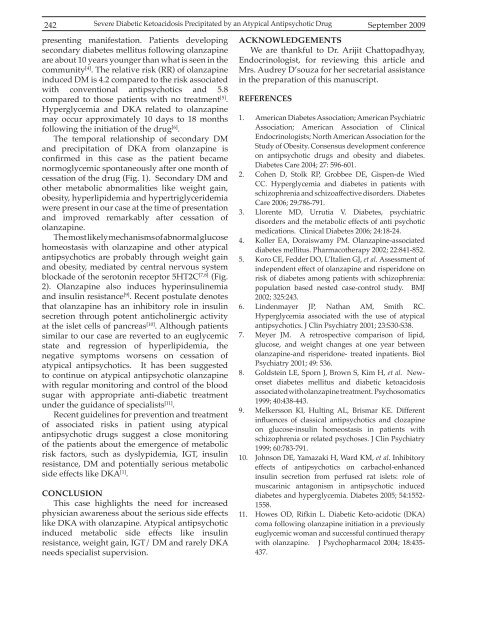Vol 41 # 3 September 2009 - Kma.org.kw
Vol 41 # 3 September 2009 - Kma.org.kw
Vol 41 # 3 September 2009 - Kma.org.kw
Create successful ePaper yourself
Turn your PDF publications into a flip-book with our unique Google optimized e-Paper software.
242<br />
Severe Diabetic Ketoacidosis Precipitated by an Atypical Antipsychotic Drug<br />
presenting manifestation. Patients developing<br />
secondary diabetes mellitus following olanzapine<br />
are about 10 years younger than what is seen in the<br />
community [4] . The relative risk (RR) of olanzapine<br />
induced DM is 4.2 compared to the risk associated<br />
with conventional antipsychotics and 5.8<br />
compared to those patients with no treatment [5] .<br />
Hyperglycemia and DKA related to olanzapine<br />
may occur approximately 10 days to 18 months<br />
following the initiation of the drug [6] .<br />
The temporal relationship of secondary DM<br />
and precipitation of DKA from olanzapine is<br />
confirmed in this case as the patient became<br />
normoglycemic spontaneously after one month of<br />
cessation of the drug (Fig. 1). Secondary DM and<br />
other metabolic abnormalities like weight gain,<br />
obesity, hyperlipidemia and hypertriglyceridemia<br />
were present in our case at the time of presentation<br />
and improved remarkably after cessation of<br />
olanzapine.<br />
The most likely mechanisms of abnormal glucose<br />
homeostasis with olanzapine and other atypical<br />
antipsychotics are probably through weight gain<br />
and obesity, mediated by central nervous system<br />
blockade of the serotonin receptor 5HT2C [7,8] (Fig.<br />
2). Olanzapine also induces hyperinsulinemia<br />
and insulin resistance [9] . Recent postulate denotes<br />
that olanzapine has an inhibitory role in insulin<br />
secretion through potent anticholinergic activity<br />
at the islet cells of pancreas [10] . Although patients<br />
similar to our case are reverted to an euglycemic<br />
state and regression of hyperlipidemia, the<br />
negative symptoms worsens on cessation of<br />
atypical antipsychotics. It has been suggested<br />
to continue on atypical antipsychotic olanzapine<br />
with regular monitoring and control of the blood<br />
sugar with appropriate anti-diabetic treatment<br />
under the guidance of specialists [11] .<br />
Recent guidelines for prevention and treatment<br />
of associated risks in patient using atypical<br />
antipsychotic drugs suggest a close monitoring<br />
of the patients about the emergence of metabolic<br />
risk factors, such as dyslypidemia, IGT, insulin<br />
resistance, DM and potentially serious metabolic<br />
side effects like DKA [1] .<br />
CONCLUSION<br />
This case highlights the need for increased<br />
physician awareness about the serious side effects<br />
like DKA with olanzapine. Atypical antipsychotic<br />
induced metabolic side effects like insulin<br />
resistance, weight gain, IGT/ DM and rarely DKA<br />
needs specialist supervision.<br />
<strong>September</strong> <strong>2009</strong><br />
ACKNOWLEDGEMENTS<br />
We are thankful to Dr. Arijit Chattopadhyay,<br />
Endocrinologist, for reviewing this article and<br />
Mrs. Audrey D’souza for her secretarial assistance<br />
in the preparation of this manuscript.<br />
REFERENCES<br />
1. American Diabetes Association; American Psychiatric<br />
Association; American Association of Clinical<br />
Endocrinologists; North American Association for the<br />
Study of Obesity. Consensus development conference<br />
on antipsychotic drugs and obesity and diabetes.<br />
Diabetes Care 2004; 27: 596-601.<br />
2. Cohen D, Stolk RP, Grobbee DE, Gispen-de Wied<br />
CC. Hyperglycemia and diabetes in patients with<br />
schizophrenia and schizoaffective disorders. Diabetes<br />
Care 2006; 29:786-791.<br />
3. Llorente MD, Urrutia V. Diabetes, psychiatric<br />
disorders and the metabolic effects of anti psychotic<br />
medications. Clinical Diabetes 2006; 24:18-24.<br />
4. Koller EA, Doraiswamy PM. Olanzapine-associated<br />
diabetes mellitus. Pharmacotherapy 2002; 22:8<strong>41</strong>-852.<br />
5. Koro CE, Fedder DO, L’Italien GJ, et al. Assessment of<br />
independent effect of olanzapine and risperidone on<br />
risk of diabetes among patients with schizophrenia:<br />
population based nested case-control study. BMJ<br />
2002; 325:243.<br />
6. Lindenmayer JP, Nathan AM, Smith RC.<br />
Hyperglycemia associated with the use of atypical<br />
antipsychotics. J Clin Psychiatry 2001; 23:S30-S38.<br />
7. Meyer JM. A retrospective comparison of lipid,<br />
glucose, and weight changes at one year between<br />
olanzapine-and risperidone- treated inpatients. Biol<br />
Psychiatry 2001; 49: 536.<br />
8. Goldstein LE, Sporn J, Brown S, Kim H, et al. Newonset<br />
diabetes mellitus and diabetic ketoacidosis<br />
associated with olanzapine treatment. Psychosomatics<br />
1999; 40:438-443.<br />
9. Melkersson KI, Hulting AL, Brismar KE. Different<br />
influences of classical antipsychotics and clozapine<br />
on glucose-insulin homeostasis in patients with<br />
schizophrenia or related psychoses. J Clin Psychiatry<br />
1999; 60:783-791.<br />
10. Johnson DE, Yamazaki H, Ward KM, et al. Inhibitory<br />
effects of antipsychotics on carbachol-enhanced<br />
insulin secretion from perfused rat islets: role of<br />
muscarinic antagonism in antipsychotic induced<br />
diabetes and hyperglycemia. Diabetes 2005; 54:1552-<br />
1558.<br />
11. Howes OD, Rifkin L. Diabetic Keto-acidotic (DKA)<br />
coma following olanzapine initiation in a previously<br />
euglycemic woman and successful continued therapy<br />
with olanzapine. J Psychopharmacol 2004; 18:435-<br />
437.
















